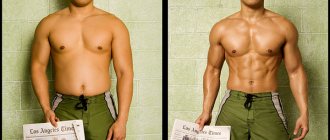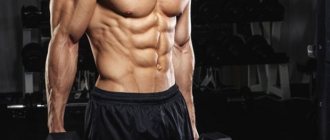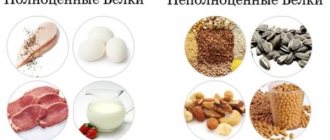Before each beach season, a huge number of people remember that it would be nice to put their body in order: get rid of excess weight, tighten muscles. This process is called weight loss and usually lasts no more than one to two months. At the same time, in bodybuilding there is such a phase as drying. Uninformed people often confuse weight loss and drying, while these are two different, albeit similar processes. So what is the difference between losing weight and cutting?
At first glance, both processes are very similar and aim to achieve the same results. In practice, they have different tasks, different time frames for achieving them, and different methods and methods.
Goals
Weight loss goal
The goal of losing weight is to lose excess weight. First of all, of course, everyone wants to remove fat. Usually, someone losing weight goes on some kind of diet (fortunately, there is a very wide choice) and enrolls in the nearest gym (sometimes he prefers outdoor activities, if the weather permits).
In most cases, a weight loss program is designed in such a way as to lose weight as quickly as possible. Please note that we are talking specifically about reducing body weight. There is no special concern for muscle preservation.
Weight loss occurs mainly by reducing the amount of water in the body and reducing muscle weight. And only last but not least can we talk about reducing the fat layer. After all, our body is very reluctant and slowly consumes fat, considering it as a kind of emergency reserve. In addition, the process of obtaining energy from fat tissue is poorly developed in most people and requires quite a long workout.
The method of losing weight is purely mechanical: by reducing caloric intake and increasing mobility.
Purpose of drying
The purpose of cutting is not only to get rid of excess fat deposits, but also to preserve the gained muscle mass and increase its rigidity and definition. A distinctive feature of drying is that it follows a period of targeted weight gain (muscle growth occurs only in conditions of a high calorie diet, when it is simply impossible to avoid fat accumulation).
An athlete, unlike just an ordinary person losing weight, is vitally interested in losing only subcutaneous fat in order to improve muscle definition, and he is not intrigued by the vague phrase “general weight loss.”
Thus, the main difference between losing weight and cutting lies in the goals. In the first case, they talk about reducing body weight in general, in the second - only about getting rid of subcutaneous fat, and, of course, while preserving muscles.
Weight loss and drying
"What is the difference?" - you ask. We have now looked at the features of drying, now we will pay attention to the process of losing weight. Afterwards the difference will become obvious. This method of improving its shape is different from drying. When losing weight, the body gets rid of fat deposits. To achieve results, fasting days and diets of varying severity are used. But don’t try to force your body into the strictest limits possible. It is best to spend a little more time on losing weight, but not to risk the results obtained.
You definitely need to give up fatty, fried and floury foods. It's hard to imagine effective weight loss when you eat cake after dinner. If there are sweets, then dark chocolate, and then in the first half of the day. As compensation, the menu includes low-calorie treats: vegetables and herbs, fruits and low-fat dairy products.
Rigidity of diets
Diet for weight loss
There are a great variety of diets for weight loss, that is, reducing body weight. Most of them really work, the only question is how good, useful and durable the result is.
Diets range from very strict (great food and calorie restrictions, fasting, etc.) to very soft (without snacking, including at night, reducing the calorie content of one meal, and so on). What the diet has in common is that when following them, eating sweets and starchy foods is usually not allowed.
Diet when cutting
Drying differs from losing weight in terms of severity and type of diet. A clearly defined period of time is allocated for it, during which the athlete must adhere to a strictly balanced diet. Deviation from the developed diet is not allowed, which sometimes usually involves regularly taking a precisely measured amount of food 5-6 times a day or more.
If we talk in more detail about the drying diet, then usually there is a very accurate calculation of the amount of proteins, fats and carbohydrates consumed. Carbohydrate reduction is carried out regularly according to the chosen plan, time frame and results. Complexes of vitamins and minerals are also required. Of course, sports nutrition is also necessary (fast forms of protein during the day, long forms at night).
conclusions
As you can see, the main difference between losing weight and cutting is the purpose of their use. If we are simply talking about the desire to fit into your favorite jeans again, then it is enough to resort to express weight loss. And drying (with the obligatory condition of first gaining muscle mass) makes muscles ideal, but does not guarantee a significant reduction in the number on the scale. And in principle, it makes no sense to torture your body by drying if you do not have important competitions ahead of you, where you need to demonstrate ideal muscles.
Obviously, the similarity between drying and losing weight is only apparent. A person who is not consciously engaged in muscle building simply does not need to think about cutting - this process is not for everyone. And it also makes no sense to consider it as a kind of diet - after all, its results are short-term. However, like the results of any type of express weight loss. This is evidenced by harsh statistics: most people who quickly lose the desired number of kilograms with the help of strict diets soon gain them back. And sometimes they add new ones.
Do you want to lose weight guaranteed and forever? Do you dream that your body is covered not by fat deposits, but by beautiful muscles? There is only one way out: gather all your willpower and start exercising regularly and eating right, changing your habits and way of thinking in general! published
Special means
If the goal is to reduce overall weight, then everything that comes to hand is often used. There will be various juices, spicy seasonings, coffee, and green tea. The distinctive feature of all this is the weak effect. Of course it's better than nothing. Especially if the goal is weight loss.
If athletes use such products when cutting, they treat them extremely carefully. All aspects of the operation of what is being used are taken into account. For example, instead of coffee, preference will be given to green tea. It is also important how a particular substance affects fat, whether it retains water, whether it contains sugar, and so on. This is a whole science, large and interesting.
The main mistake in “drying the body”
Limiting your water intake is the most common mistake both when drying the body and when losing weight. People, unknowingly, take the word “drying” literally, believing that by bringing the body to the point of dehydration, they will burn fat. This is absolutely false! It is when the body regularly receives a sufficient amount that the metabolism improves, the most effective cleansing occurs and weight loss occurs. At the same time, we draw your attention to the fact that body volumes quickly begin to disappear, as the body stops retaining liquid for fear of dehydration.
Efficiency
What is more effective: losing weight or cutting? The answer is not so obvious, since the goals and quality criteria are different.
In case of weight loss, the result is monitored using floor scales and a mirror. The process ends when what is seen begins to suit the person losing weight, or when the nerves give in. Next, it is important to maintain the achieved result. This is where the problem lies. Statistics say that about 95% of people who have lost weight gain the weight back very quickly, and in the end they end up with even more weight than they started losing weight with. Maintaining results requires a lot of willpower, changing habits and thinking. This is facilitated by calm, leisurely weight loss.
Drying, in turn, is carried out for the result, which is regularly assessed by both the athlete himself and the coach. And then also as judges at competitions. The result is a maximally sculpted body with a minimum of subcutaneous fat and water. This state is not healthy and unnatural. Therefore, after the competition for which drying was carried out, the athlete must gradually return to his normal diet. Thus the body also changes. But this change (in general, a small increase in water and fat) cannot be considered as a loss of results, since the goal has already been achieved.
What do athletes eat?
What is the difference between nutrition for weight loss and cutting? In the first case, a person uses the diet that suits him best. This may be a harder or softer diet. But usually they are united by the need to give up flour and sweets. Typically, a diet in this case is a way of life that you need to choose for yourself and stick to it on an ongoing basis.
Drying is quite an ordeal. It involves severe restriction of the diet, not only in food, but also in liquid. The athlete must constantly count the number of calories he consumes, especially carbohydrates and fats. Of course, this course is short-term, but quite difficult. After drying, athletes usually return to their normal state.
Is it possible and necessary for everyone to dry themselves?
Can an ordinary person, not an athlete, refuse to lose weight? And, like bodybuilders, get rid of excess weight using a set of drying measures? No, and here's why:
- drying is violence against the body; professional athletes are in a state of constant stress for several months
- drying requires the use of a special, monotonous diet
- drying requires deep knowledge in nutrition, biochemistry, and so on
- drying involves active, frequent, specific training
- cutting also means maintaining the achieved level of muscle mass (which most people simply do not have), which requires taking special sports nutrition
The duration and severity of drying make it unsuitable for use by people who do not set themselves any competitive goals.
- Tweet
Sports loads during drying
The training program changes significantly when you switch to correcting your silhouette. This means that muscle mass is already there, and thorough work has been done on it. During this period, sports activities are used. The program may include barbell press and deadlift. But drying the body for girls will not do without aerobic exercise. In fact, the result of the entire process will depend on this. Aerobic exercise should serve to provide tissues with oxygen, which will improve performance and speed up metabolism.
How and when to replenish your water balance?
In everyday life, we drink water when we already feel thirsty. It should be understood that if you feel thirsty, then at the moment the body has already lost 2% of its weight along with liquid. Therefore, when sitting down to dry your body, you should drink water according to the recommended scheme at regular intervals. And it doesn’t matter whether you want to drink purified water at that moment or not.
Water in the body plays an irreplaceable role, both in activating fat burning processes and in restoring strength after physical activity. Lack of fluid in the body can lead to dehydration and, as a result, slow down normal metabolism. It is recommended to drink up to 500 ml of purified water two hours before training, then drink another 100 ml 10 minutes before the start. During exercise, drink at least 100 ml of water every 15-20 minutes. After finishing the training process, drink another 200 ml of water, so the body can fully restore fluid loss.
What affects the need for water?
Each organism is individual and this should be taken into account when considering the question, what affects the need for water? In this case, important points that can affect fluid requirements are:
- A person's lifestyle and age.
- Professional sports.
- Physical and mental stress.
- Human nutrition.
- Drinking alcohol and smoking.
- Pregnancy and lactation period.
- Use of coffee and other drinks.
As we can see, it is difficult to say how much purified water a person should consume. But you need to know when a person drinks insufficient amounts of water, his body volume increases. This occurs as a result of the fact that the cells simply begin to accumulate fluid without knowing when the next supply of water will be.
At the same time, you need to understand that simply filtered water is beneficial for the body, and not boiled water. Coffee and tea do not count towards fluid intake.










